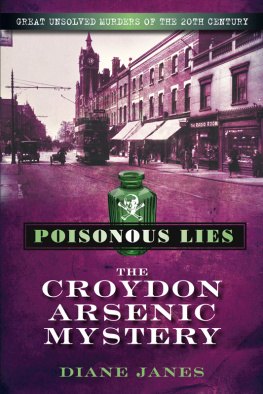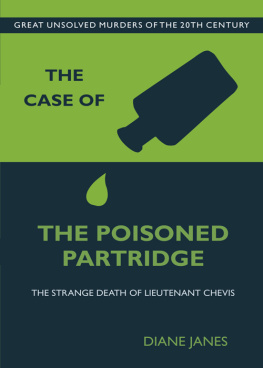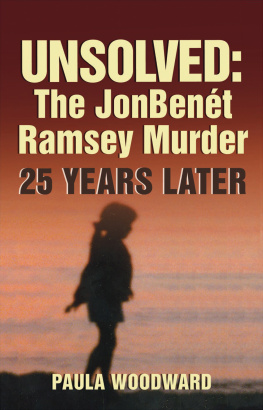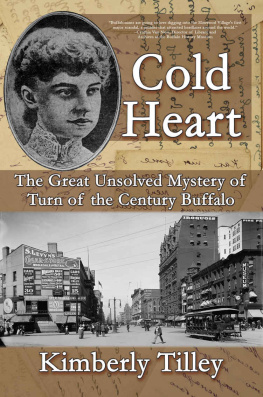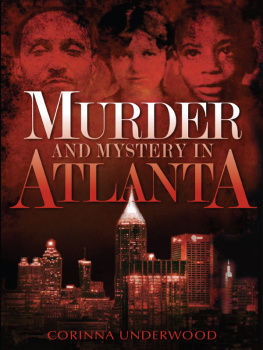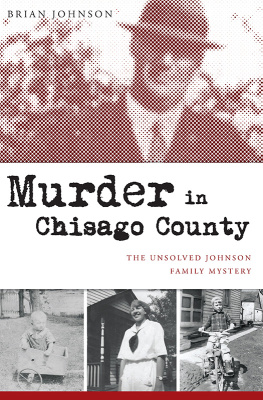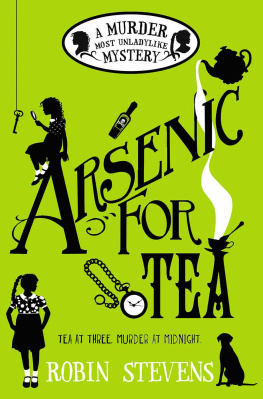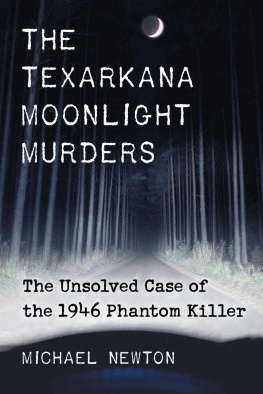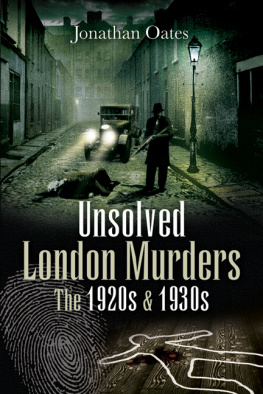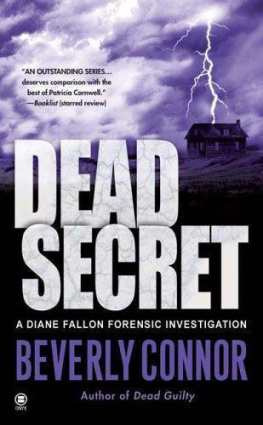POISONOUS LIES
THE
CROYDON
ARSENIC
MYSTERY
GREAT UNSOLVED MURDERS OF THE 20TH CENTURY
POISONOUS LIES
THE
CROYDON
ARSENIC
MYSTERY
DIANE JANES

For Hector
First published 2010
The History Press
The Mill, Brimscombe Port
Stroud, Gloucestershire, GL5 2QG
www.thehistorypress.co.uk
This ebook edition first published in 2013
All rights reserved
Diane Janes, 2010, 2013
The right of Diane Janes to be identified as the Author of this work has been asserted in accordance with the Copyright, Designs and Patents Act 1988.
This ebook is copyright material and must not be copied, reproduced, transferred, distributed, leased, licensed or publicly performed or used in any way except as specifically permitted in writing by the publishers, as allowed under the terms and conditions under which it was purchased or as strictly permitted by applicable copyright law. Any unauthorised distribution or use of this text may be a direct infringement of the authors and publishers rights, and those responsible may be liable in law accordingly.
EPUB ISBN 978 0 7509 5437 2
Original typesetting by The History Press
Ebook compilation by RefineCatch Limited, Bungay, Suffolk

ACKNOWLEDGEMENTS
T his book would not have been possible without extensive use of the facilities provided by the National Archives and the British Library Newspaper Section at Colindale, whose staff have provided me with their usual good service. I would also like to thank Chris Bennett and the team at Croydon Local Studies & Archives who have been unfailingly helpful and welcoming, as were the staff I encountered at the Wellcome Collection. I am grateful to Joan Self of the National Meteorological Archive and Jeremy Downer of Sutton & East Surrey Water Company, who swiftly provided me with the data I requested, and also for the help and information received from Lisa Lawson of Croydon Community Services, Lesley at Sevenoaks Library and various members of staff at J.B. Shakespeare Ltd.
Dr Sacha Kolar generously provided me with the benefit of his expertise in the field of pathology, Drs Ann and Barry Colville patiently answered my questions about symptoms, diagnoses and their collective experience of general practice and Dr John Bergin and his wife Pamela shared valuable insights about the life of a general practitioner in the 1920s.
I am greatly indebted to Mary-Virginia Christakos, her son Paul Christakos and to Hazel and Ben Cottis, who provided the photographs of the Duff and Sidney families which illustrate this book and who gave generously of their time and shared their memories of the people involved.
Peter Woolley came to the rescue yet again when a sketch of a long-vanished building was needed, and together with Erica Woolley provided a level of interest and support which goes beyond mere friendship. I would also like to thank Margaret and Eric Thomas and indeed all the friends and family who have put up with conversations about arsenic over the last three years.
Finally I must thank my husband Bill, whose love and encouragement makes everything possible.

CHAPTER ONE
A HAPPY, UNITED FAMILY
M rs Violet Sidney breathed her last at around 7.20 on the evening of Tuesday, 5 March 1929. She expired in the front bedroom of 29 Birdhurst Rise, South Croydon: a large Victorian villa complete with attics and cellars the very place in which to stage a melodramatic murder mystery and in a coincidence entirely in keeping with the set piece detective story which Violets death was about to become, all the principal suspects were on the premises at the time.
There was Kathleen Noakes, the household servant who was responsible for providing all the meals at no.29 a distinctly uncomfortable position to hold in a household whose address was shortly to become synonymous with poisoning. Moreover, far from being a trusted old family retainer, Mrs Noakes had only arrived on the premises six months earlier and was already working her notice. Another contender in this speculative list was Dr Robert Elwell, who had been present at the deathbeds of all three members of this unfortunate family whose deaths would shortly be perceived suspicious. In itself the presence of the family doctor was hardly remarkable, but Dr Elwells involvement took on a particular significance in the light of a rumour that he was enamoured of Mrs Sidneys daughter, Grace Duff. Dr Elwells partner, Dr John Binning, was also in the house, and although not considered a suspect at the time, Dr Binning was a major participant in the unfolding drama, and questions about his involvement would arise later.
Violet Sidneys two surviving children were at her bedside and, needless to say, they both stood to benefit under their mothers will although it would later be suggested that her son Toms real motive for murder could have been a desire to break free from his mother and start a new life in America. And finally, what of Violet Sidneys daughter, Grace? Grace would eventually emerge as the most favoured suspect of all with many willing to believe her sufficiently avaricious or deranged, that over a period of just under a year, she masterminded the murder of three members of her immediate family.
Before her death, Violet Sidney had lived quietly in South Croydon for more than a decade. Ladylike, reserved and rather old-fashioned, Violet had attended the local church and run her household, tended her garden, received callers and made visits; to all intents and purposes a very ordinary, very private life. Yet within days of her death her name would be headline news and the lives of herself and her family would be illuminated in a blaze of publicity. Magazines and newspapers would speculate about them, whole books would be devoted to their fate; eventually they would be represented by actors and actresses in a medium which was then scarcely known television. It would be suggested that Violet had been murdered by her beloved son Tom, or more frequently that she was done to death by her daughter Grace. There would even be speculation that she herself had murdered two members of her family, before taking her own life in a belated fit of remorse. Every theory was possible, because in spite of a series of inquests, a long police investigation, and massive public interest, the Croydon Arsenic Mystery has never been solved.
The Metropolitan Polices desperate attempts to pursue every lead are well illustrated by the reaction of Croydon detectives on receiving a letter from Utah some five years after the investigation had faltered to a halt. The author claimed to know something about the case and, in spite of the letter being written in blue crayon and couched in the vaguest of terms, Detective Inspector Morrish, who was by then in charge of the Croydon case, took this missive seriously enough to contact the American authorities in order to have the matter followed up. It transpired that the author was a mental patient who made a habit of writing to various individuals (including ex-President Calvin Coolidge) claiming to be in receipt of answers to a variety of outstanding mysteries, courtesy of information received via dreams.
The Utah letter is just one of numerous crank communications which survive in the police files; letters came from as far afield as New York and the Leeward Island news of the mystery had spread around the world and everyone apparently had a theory. The Croydon Poisonings swiftly achieved classic status, with accounts appearing in one true crime compendium after another. As a murder mystery the case truly had everything except a definitive solution. In 1975 Richard Whittington-Egan claimed to provide the answer in his book

